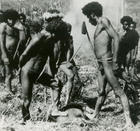 “Nova Guinea” was discovered by the Spanish and the Portuguese in the early sixteenth century.
“Nova Guinea” was discovered by the Spanish and the Portuguese in the early sixteenth century.
The Dutch East India Company organized expeditions to acquire slaves, tropical woods, and other trade products from the ”Papoas” during the seventeenth century.
Sultans from the Moluccan islands did so too.
Dutch activities were recorded by the contemporary historian François Valentijn.
Arnold de Vlamingh van Outshoorn, Governor of the Moluccan islands, visited five “Papoan islands” during the Ambon Wars (1651-1656). He did not encounter any living Papuan, but “just to do something useful, casually burned down two villages”.(Valentijn 1, p 308)
 A certain Mr Vink went to Nova Guinea on 5 April 1663 to buy slaves.
A certain Mr Vink went to Nova Guinea on 5 April 1663 to buy slaves.
As soon as he had landed, around a hundred boats laden with trade products (coconuts, sago, pigs, fish, and a few slaves) appeared.
The Dutchmen purchased a woman for clothes worth 13 dollars, but she turned out to be “a lame lass” and they felt deceived.
They were informed about an earlier expedition by two fellow countrymen: “the Papuans of Isera had feasted on them and gnawed their severed heads to the bone for six days long”.
Vink left hurriedly.(Valentijn 3, p 58-61)
 On 19 July 1678 “chief company tradesman” Johannes Keyts encountered Moluccan anchorages and trading posts.
On 19 July 1678 “chief company tradesman” Johannes Keyts encountered Moluccan anchorages and trading posts.
The Moluccas had an agreement with the local Papuans to kill any other foreigner who tried to enter Nova Guinea.
Even so, Keyts landed and raised the Dutch flag.
He bought slaves and massoy, a tropical wood.(Valentijn 3, p 64)
Observations made by the Dutchmen
 This Nova Guinea is a very large country indeed, and this is where the unknown South Land begins.
This Nova Guinea is a very large country indeed, and this is where the unknown South Land begins.
But we must admit that knowledge about these lands and about the Papoas is lacking.
The Papoan islands are visited mostly by people from the Moluccas for their slaves, massoy, the rind of a fragrant tree, birds of paradise and other small birds, and pearls, ambre gris [a perfume].(Valentijn 3, p 47 )
These South Landers are of an extremely black complexion. Long and robust and totally naked, apart from their genitals. (Valentijn 3, p. 47)
The country is rugged and wild, and mountainous in many places. The climate is misty and cloudy. The people are not too bad as far as their build, character, and communicative skills are concerned, but they are not to be trusted. (Valentijn 3, p. 64)
